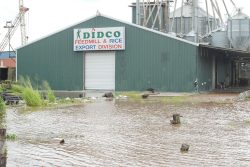ExxonMobil continues to flare daily 12 million -15 million cubic feet of gas from its offshore oil operations and has not given the EPA any possible cessation dates.
It has missed its August 10th promised deadline to contain flaring and has now flared a total of more than 10.2 billion cubic feet in the offshore Stabroek Block as of yesterday,
“They are still having equipment problems and have to send the equipment back to Germany and they have not given us a date as to when flaring will cease the 12-15M cubic feet per day,” Environmental Protection Agency (EPA) Director Dr Vincent Adams told Stabroek News yesterday.
The company says that it was due to continued compressor problems and that it was working to resolve the issue.
“As regards flaring, we have encountered additional challenges with a gas compressor. Our teams are working tirelessly to resolve these issues. Despite this latest setback, we have significantly reduced flaring as we safely progress commissioning of other parts of the gas compression system on the Liza Destiny.”
“Unfortunately, restrictions associated with the COVID-19 pandemic continue to impact our ability to bring key workers and equipment into the country, thereby slowing the progress of related activities. We are currently limiting oil production and injecting or using more than 85% of the associated gas produced from the reservoir with two of the three gas handling systems online. Once the full system is commissioned, we will increase oil production to full capacity and only a pilot flare will remain for safety,” ExxonMobil’s Public and Government Affairs Advisor Deedra Moe was quoted as saying.
President Irfaan Ali has signalled a likely tougher stance on Exxon when he told Stabroek News that the approval of the third of Exxon’s planned wells, Payara, will be put on hold for a review. Exxon has been pressing for swift approvals.
His position was echoed by his Vice President Bharrat Jagdeo who last week said that the environmental issues for all projects of the US oil major must be harnessed as he underscored that this country will continue to uphold its end in relation to climate change commitments.
Jagdeo, who brokered Guyana’s forest pact with Norway that saw this country rake in billions in revenue, said that his government will not sacrifice environmental sustainability for revenue and will always safeguard its people against footing any bills for disasters from the oil & gas sector. “We will ensure that we have a commitment from ExxonMobil, because all of these issues are interlinked, a commitment that there will be adequate provisions for any environmental disaster, in the contract and by Exxon. We have to satisfy ourselves that that is so. Flaring [from oil extraction] is a key issue and we have to deal with that. We have already signalled that we don’t want flaring. We don’t want flaring,” he had said.
Exxon has flared huge amounts of gas from its offshore operations and is now under close scrutiny from the Environmental Protection Agency.
The World Wildlife Fund, as well as a global environmental and human rights organisation, the Center for International Environmental Law (CIEL), have pointed to the effects of the greenhouse gas emissions on the environment, as they condemned the act.
Questioned on the environmental effects of flaring and about the long start-up, the company had said that its contract with this country allows for routine and emergency flaring but that it would scale back on production and limit flaring to 12 million cubic feet per day.
The EPA’s Director said that flaring is an issue that is being dealt with as it pertains to future permits.
“We are taking steps to modify the language in the current and future permits. It is enshrined in the EPA Act that the agency can modify a permit at any time. The EPA Act says that not only the agency can modify and change the permit at any time, but there are provisions that it can also terminate a permit,” Adams said.










